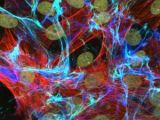Why is it that a surgery that it should have turned you into Adriana Lima has as result a scarecrow face? And why don't many transplants work properly? A new EPFL research explains the mechanical factors that are essential in the differentiation and function of fibroblasts - connective tissue cells controlling wound healing and scarring.
In case of injury, specialized cells called fibroblasts gather beneath the skin surface into the temporary wound matrix (the clot) and start releasing collagen that will close the wound very rapidly.
At the beginning, this matrix is soft and filled with growth factors, but the "crawling" fibroblasts reorganize the fibers, turning it stiffer, and at a given moment, the fibroblasts stop crawling and turn into powerful contractile cells anchored into the matrix, pulling the edges of the wound for uniting them.
The new study has found a mechanical process that is essential for this change of the fibroblasts. The shift requires a growth factor that stimulates the synthesis of smooth-muscle proteins.
Previously, it was believed that the fibroblasts accomplished this by digesting the matrix fibers. The new research shows that cells release the growth factor through a purely mechanical process. By testing on cell culture substrates of various rigidity, the researchers discovered that, at a certain point, the matrix is rigid enough for the cell-exerted force to make the growth factor pop out.
Further on, the growth factor boosts the synthesis of the contractile proteins that pull the matrix tight. The contraction further stimulates the release of the growth factor, which makes fibroblasts turn more contractile. The mechanical nature of the switch triggers the contraction only on the proper moment for the matrix.
This process heals, but if overexpressed, it can form fibrous tissue. Trauma to vital organs like the heart, lung, liver and kidney, can make fibroblasts grow fibrous strands, and the forming of excessive scar tissue (called "fibrosis") can impede the organ's function, leading even to death.
In implants too, fibroblasts can work wrong: if the implant is too smooth, the body won't be able to incorporate it, but too rough an implant means fibrosis. In the case of plastic surgery, this causes excessive scarring.
In the case of mesenchymal stem cell cultures, a stiff substrate can make them transform into fibroblasts, instead of the aimed tissue.
"This new understanding of the mechanical nature of fibroblast activation could be used to reduce or prevent fibrosis from occurring, without inhibiting the growth factor, which serves many other vital functions in the body. You could interfere with the way the cells grab onto the growth factor complex, you could interfere with their attachment points on the matrix, and you could interfere with their contractile forces so that the matrix never gets stiff enough to liberate the growth factor", said lead researcher Boris Hinz.

 14 DAY TRIAL //
14 DAY TRIAL // 
